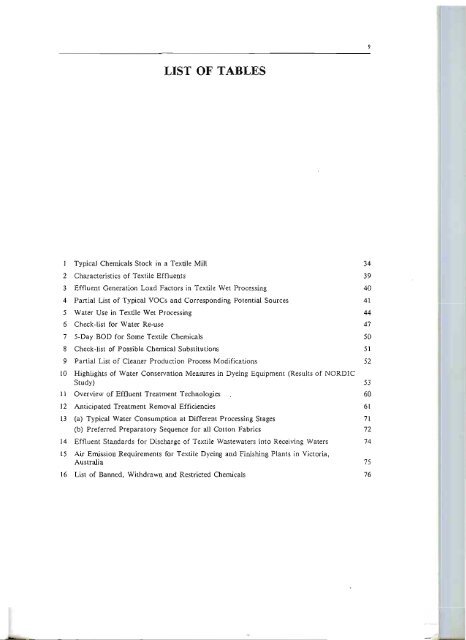Contributor, The Textile Industry and the Environment, UNEP
Contributor, The Textile Industry and the Environment, UNEP
Contributor, The Textile Industry and the Environment, UNEP
You also want an ePaper? Increase the reach of your titles
YUMPU automatically turns print PDFs into web optimized ePapers that Google loves.
LIST OF TABLES<br />
1 Typical Chemicals Stock in a <strong>Textile</strong> Mill 34<br />
2 Characteristics of <strong>Textile</strong> Effluents 39<br />
3 Effluent Generation Load Factors in <strong>Textile</strong> Wet Processing 40<br />
4 Partial List of Typical VOCs <strong>and</strong> Corresponding Potential Sources 41<br />
5 Water Use in <strong>Textile</strong> Wet Processing 44<br />
6 Check-list for Water Re-use 47<br />
7 5-Day BOD for Some <strong>Textile</strong> Chemicals 50<br />
8 Check-list of Possible Chemical Substitutions 51<br />
9 Partial List of Cleaner Production Process Modifications 52<br />
10 Highlights of Water Conservation Measures in Dyeing Equipment (Results of NORDIC<br />
Study) 53<br />
11 Overview of Effluent Treatment Technologies 60<br />
12 Anticipated Treatment Removal Efficiencies 61<br />
13 (a) Typical Water Consumption at Different Processing Stages 71<br />
(b) Preferred Preparatory Sequence for all Cotton Fabrics 72<br />
14 Effluent St<strong>and</strong>ards for Discharge of <strong>Textile</strong> Wastewaters into Receiving Waters 74<br />
15 Air Emission Requirements for <strong>Textile</strong> Dyeing <strong>and</strong> Finishing Plants in Victoria,<br />
Australia 75<br />
16 List of Banned, Withdrawn <strong>and</strong> Restricted Chemicals 76<br />
9

















